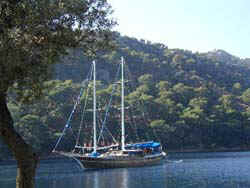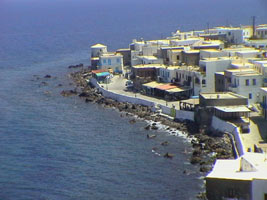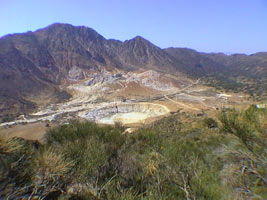 |
|
||
Nisyros is a small island in the Dodecanese complex, between Kos and Tilos. It is a quiet place, far from the tourist current other Greek islands have, that fascinates and charms visitors with its strong colourful character, the dark brown of its volcanic earth, the white of its houses and the deep blue of its sea. Nothing disturbs the silence of the island, which gives it a mysterious charm that remains with visitors who almost always fall in love with Nisyros and cherish its memories One of the natural attractions of Nisyros island is the volcano, on its central side, near the village of Nikia, on the plateau of Lakki. It's an active volcano with a large crater into which one can descend by steps. Entering the crater, one could easily believe that one was walking on the moon, were it not for the hot sun that shines above in all its glory. The crater is layered with a hot surface (not hot enough to scold, one can easily walk on it but shoes, preferably mountain boots are most definitely required) and thick vapours, and is frequently visited by tourists from the nearby Greek islands.Nisyros also has therapeutic springs with good curative properties at Loutra, near the capital.A traditional product of Nisyros is soumada, a non-alcoholic almond-flavoured drink. The patron saint of the island is Saint Nikitas. Many Orthodox Christian churches are found on the island, as well as four monasteries which are not inhabited by monks today, although various celebrations take place in them. The largest monastery is the one of Panagia Spiliani (Blessed Virgin Mary of the cave) at Mandraki. It is built beside the medieval castle erected by the Knights Hospitaller who conquered the island in 1315. The history of Nisyros is closely linked with the volcanic eruptions that occurred in the ancient past. The first known inhabitants of the island were Karrians but recent evidence has found relics left by people from Kos, Thessaly and Rhodes during the ancient times of Greek History. According to the Greek Mythology, Nisyros was was born by a stone that Poseidon throw to the Giant Polyvoti during the fight of Gods against the Giants. The history of Nissyros and its growth, because of its proximity, was linked to that of Rhodes. In modern times, the development of Nissyros is due to the investments made by ex-patriots who emigrated after the Second World War. Up until 1948 when the island unified with Greece, like all of the Dodecanese, Nisyros was an Italian colony. Places to visit on NisyrosMandraki: The Old Fortress (Paleokastro) with the ruins of the ancient city lies 4 km southwest. Sections of the fortified walls |
||




 Nisyros Island
Nisyros Island
 Nisyros History
Nisyros History dating from the 4th century BC and the gateway structure have survived. They are strongly reminiscent of similar Mycenean structures.
dating from the 4th century BC and the gateway structure have survived. They are strongly reminiscent of similar Mycenean structures.
